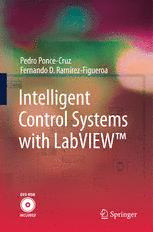
Intelligent Control Systems with LabVIEW™ PDF
Preview Intelligent Control Systems with LabVIEW™
Intelligent Control Systems with LabVIEW™ Pedro Ponce-Cruz (cid:129) Fernando D. Ramírez-Figueroa Intelligent Control Systems with LabVIEW™ 123 PedroPonce-Cruz,Dr.-Ing. FernandoD.Ramírez-Figueroa,ResearchAssistanttoDoctorPonce InstitutoTecnológicodeEstudiosSuperioresdeMonterrey CampusCiudaddeMéxico CalledelPuente222 Col.EjidosdeHuipulcoTlalpan 14380,México,D.F. México [email protected] ISBN978-1-84882-683-0 e-ISBN978-1-84882-684-7 DOI10.1007/978-1-84882-684-7 SpringerLondonDordrechtHeidelbergNewYork BritishLibraryCataloguinginPublicationData AcataloguerecordforthisbookisavailablefromtheBritishLibrary LibraryofCongressControlNumber:2009933628 ©Springer-VerlagLondonLimited2010 BASICStamp®isafederallyregisteredtrademarkofParallaxInc.Parallax™andPing)))™aretrade- marksofParallaxInc.,http://www.parallax.com Bluetooth®wordmarkisownedbytheBluetoothSIG,Inc.http://www.bluetooth.com EmbeddedBlue™isatrademarkofA7Engineering,Inc.http://www.a7eng.com NIrefers toNational Instruments andallofits subsidiaries, business units,anddivisions worldwide. LabVIEW™isatrademarkofNationalInstruments.Thisbookisanindependentpublication.National Instrumentsisnotaffiliatedwiththepublisherortheauthor,anddoesnotauthorize,sponsor,endorseor approvethisbook.NationalInstrumentsCorporation,11500NMopacExpwy,Austin,TX78759-3504, U.S.A.http://www.ni.com Apartfromanyfairdealingforthepurposesofresearchorprivatestudy,orcriticismorreview,asper- mittedundertheCopyright, DesignsandPatents Act1988,thispublication mayonlybereproduced, storedortransmitted,inanyformorbyanymeans,withthepriorpermissioninwritingofthepublish- ers,orinthecaseofreprographicreproductioninaccordancewiththetermsoflicensesissuedbythe CopyrightLicensingAgency.Enquiriesconcerningreproductionoutsidethosetermsshouldbesentto thepublishers. Theuseofregisterednames,trademarks,etc.,inthispublicationdoesnotimply,evenintheabsenceof aspecificstatement,thatsuchnamesareexemptfromtherelevant lawsandregulations andtherefore freeforgeneraluse. Thepublishermakesnorepresentation,expressorimplied,withregardtotheaccuracyoftheinformation containedinthisbookandcannotacceptanylegalresponsibilityorliabilityforanyerrorsoromissions thatmaybemade. Thepublisherandtheauthorsacceptnolegalresponsibilityforanydamagecausedbyimproperuseof theinstructionsandprogramscontainedinthisbookandtheDVD.Althoughthesoftwarehasbeentested withextremecare,errorsinthesoftwarecannotbeexcluded. Coverdesign:eStudioCalamar,Figueres/Berlin Printedonacid-freepaper SpringerispartofSpringerScience+BusinessMedia(www.springer.com) Thisbookisdedicatedtomymotherandsonwithlove. PedroPonce To my parents Virginia and Fernando because this would not be possible without theirunconditionalloveandsupport,andtomyadvisorandfriend,Pedroforgiving me the opportunity to prove myself, and to all those who have accompanied me alongthiswonderfuljourneyofknowledgeandcreation. DavidRamirez Preface Controlsystemsarebecomingmoreimportanteveryday.Atthebeginning,thein- dustryusedsequentialcontrolsforsolvingalotofindustrialapplicationsincontrol systems,andthenthelinearsystemsgaveusahugeincreaseinapplyingautomatic linearcontrolonindustrialapplication.Oneofthemostrecentmethodsforcontrol- lingindustrialapplicationsisintelligentcontrol,whichisbasedonhumanbehavior orconcerningnaturalprocess. Nowadays,the topic of intelligentcontrolsystems has becomemore than a re- searchsubjecttotheindustry.Thenumberofindustrialapplicationsisgrowingev- eryday,fasterandfaster.Thus,newsoftwareandhardwareplatformsarerequired inordertodesignanddevelopintelligentcontrolsystems.Thechallengeforthese typesofsystemsistohaveanovelplatform,whichallowsdesigning,testingandim- plementinganintelligentcontrollersysteminashortperiodoftime.Fortheindustry andacademy,LabVIEW™isoneofthemostimportantsoftwareplatformsforde- velopingengineeringapplicationsandcouldbeconnectedwithdifferenthardware systems,aswellasrunningstandaloneprogramsforsimulatingthecontroller’sper- formance(validatingthecontrollerbysimulationthenimplementingit).Inaddition, LabVIEWisagraphicalprogramthatisveryeasytolearn. Taking into account these advantages, the software platform described in this bookisLabVIEWfromNationalInstruments™.Thebookisdividedinto7chapters andgivesalltheinformationrequiredfordesigningandimplementinganintelligent controller. Chapter1providesanintroductiontobasicintelligentcontrolconceptsandcon- cludesbyapplyingLabVIEWforimplementingcontrolsystems.Chapter2covers in deep detail the fuzzy logic theoryand implementation.This chapter starts with fundamentalfuzzylogictheoryforsupportingthemostimportantfuzzylogiccon- trollersimplementedusingLabVIEW. Chapter 3 deals with artificial neural networks. In this chapter a complete set of tools for implementing artificial neural networks is presented. Basic examples of neuralnetworks, such as perceptron,allow the students to understandthe most importanttopologiesinartificialneuralnetworksformodelingandcontrollingsys- tems. In Chap. 4 the reader can find neuro-fuzzy controllers, which combine the vii viii Preface fuzzyinferencesystemswithanartificialneuralnetworktopology.Thus,theneuro- fuzzy controllers are an interesting option for modeling and controlling industrial applications. Chapter 5 discusses genetic algorithms,which are representationsof the natural selection process. This chapter also examines how generic algorithms can be used as optimization methods. Genetic programming is also explained in detail. Chapters 6 and 7 show different algorithms for optimizing and predicting that could be combined with the conventional intelligent system methodologies pre- sented in the previouschapters such as fuzzy logic, artificial neural networksand neuro-fuzzysystems.The methodspresentedin Chaps.6 and7 are:simulatedan- nealing,fuzzyclusteringmeans,partitioncoefficients,tabusearchandpredictors. Supplemental materials supporting the book are available in the companion DVD. The DVD includes all the LabVIEW programs (VIs) presented inside the bookforintelligentcontrolsystems. Thisbookwouldneverhavebeenpossiblewithoutthehelpofremarkablepeople who believedin this project.I am notable to acknowledgeall of them here, but I wouldliketothankEloisaAcha,GustavoValdes,JeannieFalcon,JavierGutierrez andothersatNationalInstrumentsforhelpingustodevelopabetterbook. Finally, I would like to thank the Instituto Tecnológico de Monterrey campus CiudaddeMéxicoforsupportingthisresearchproject.Iwish torememberallmy friendsandcolleagueswhogavemesupportduringthisresearchjourney. ITESM-CCM Dr.PedroPonce-Cruz MéxicoCity Contents 1 IntelligentControlforLabVIEW ................................ 1 1.1 Introduction ............................................... 1 1.2 IntelligentControlinIndustrialApplications.................... 3 1.3 LabVIEW................................................. 4 References..................................................... 7 2 FuzzyLogic ................................................... 9 2.1 Introduction ............................................... 9 2.2 IndustrialApplications ...................................... 9 2.3 Background ............................................... 10 2.3.1 UncertaintyinInformation ............................ 11 2.3.2 ConceptofFuzziness................................. 11 2.4 FoundationsofFuzzySetTheory ............................. 11 2.4.1 FuzzySets.......................................... 12 2.4.2 BooleanOperationsandTerms......................... 14 2.4.3 FuzzyOperationsandTerms........................... 15 2.4.4 PropertiesofFuzzySets .............................. 18 2.4.5 Fuzzification ........................................ 18 2.4.6 ExtensionPrinciple .................................. 21 2.4.7 AlphaCuts ......................................... 23 2.4.8 TheResolutionPrinciple.............................. 24 2.4.9 FuzzinessofUncertainty.............................. 24 2.4.10 PossibilityandProbabilityTheories..................... 25 2.5 FuzzyLogicTheory ........................................ 26 2.5.1 FromClassicaltoFuzzyLogic ......................... 26 2.5.2 FuzzyLogicandApproximateReasoning................ 26 2.5.3 FuzzyRelations ..................................... 28 2.5.4 PropertiesofRelations................................ 28 2.5.5 Max–MinComposition ............................... 29 2.5.6 Max–StarComposition ............................... 30 2.5.7 Max–AverageComposition............................ 31 ix x Contents 2.6 FuzzyLinguisticDescriptions ................................ 31 2.7 TheFuzzyLogicController.................................. 33 2.7.1 LinguisticVariables .................................. 33 2.7.2 MembershipFunctions ............................... 33 2.7.3 RulesEvaluation..................................... 33 2.7.4 MamdaniFuzzyController ............................ 34 2.7.5 Structure ........................................... 34 2.7.6 Fuzzification ........................................ 34 2.7.7 RulesEvaluation..................................... 35 2.7.8 Defuzzification ...................................... 35 2.7.9 TsukamotoFuzzyController........................... 35 2.7.10 Takagi–SugenoFuzzyController ....................... 36 2.7.11 Structure ........................................... 36 2.7.12 Fuzzification ........................................ 36 2.7.13 RulesEvaluation..................................... 36 2.7.14 CrispOutputs ....................................... 37 2.8 ImplementationoftheFuzzyLogicControllers UsingtheIntelligentControlToolkitforLabVIEW .............. 37 2.8.1 Fuzzification ........................................ 38 2.8.2 RulesEvaluation..................................... 40 2.8.3 Defuzzification:CrispOutputs ......................... 41 2.9 ClassicalControlExample................................... 43 References..................................................... 46 FutherReading ................................................. 46 3 ArtificialNeuralNetworks ...................................... 47 3.1 Introduction ............................................... 47 3.2 ArtificialNeuralNetworkClassification........................ 55 3.3 ArtificialNeuralNetworks................................... 56 3.3.1 Perceptron.......................................... 57 3.3.2 Multi-layerNeuralNetwork ........................... 60 3.3.3 TrigonometricNeuralNetworks........................ 71 3.3.4 KohonenMaps ...................................... 79 3.3.5 BayesianorBeliefNetworks........................... 84 References..................................................... 87 FutherReading ................................................. 88 4 Neuro-fuzzyControllerTheoryandApplication ................... 89 4.1 Introduction ............................................... 89 4.2 TheNeuro-fuzzyController.................................. 90 4.2.1 TrigonometricArtificialNeuralNetworks................ 91 4.2.2 FuzzyClusterMeans ................................. 96 4.2.3 PredictiveMethod ................................... 98 4.2.4 ResultsUsingtheController...........................100 4.2.5 ControllerEnhancements .............................101 Contents xi 4.3 ANFIS:AdaptiveNeuro-fuzzyInferenceSystems ...............106 4.3.1 ANFISTopology ....................................108 References.....................................................122 FutherReading .................................................122 5 GeneticAlgorithmsandGeneticProgramming ....................123 5.1 Introduction ...............................................123 5.1.1 EvolutionaryComputation ............................123 5.2 IndustrialApplications ......................................124 5.3 BiologicalTerminology .....................................125 5.3.1 SearchSpacesandFitness.............................125 5.3.2 EncodingandDecoding...............................125 5.4 GeneticAlgorithmStages....................................126 5.4.1 Initialization ........................................127 5.4.2 Selection ...........................................128 5.4.3 Crossover...........................................129 5.4.4 Mutation ...........................................130 5.5 GeneticAlgorithmsandTraditionalSearchMethods .............134 5.6 ApplicationsofGeneticAlgorithms ...........................135 5.7 ProsandConsofGeneticAlgorithms..........................136 5.8 SelectingGeneticAlgorithmMethods .........................136 5.9 MessyGeneticAlgorithm....................................137 5.10 OptimizationofFuzzySystemsUsingGeneticAlgorithms........138 5.10.1 CodingWholeFuzzyPartitions ........................138 5.10.2 StandardFitnessFunctions ............................139 5.10.3 CodingRuleBases...................................139 5.11 AnApplicationoftheICTLfortheOptimization ofaNavigationSystemforMobileRobots .....................140 5.12 GeneticProgrammingBackground............................143 5.12.1 GeneticProgrammingDefinition .......................143 5.12.2 HistoricalBackground................................144 5.13 IndustrialApplications ......................................144 5.14 AdvantagesofEvolutionaryAlgorithms........................144 5.15 GeneticProgrammingAlgorithm .............................145 5.15.1 Length .............................................146 5.16 GeneticProgrammingStages.................................146 5.16.1 Initialization ........................................146 5.16.2 Fitness .............................................147 5.16.3 Selection ...........................................147 5.16.4 Crossover...........................................147 5.16.5 Mutation ...........................................148 5.17 VariationsofGeneticProgramming ...........................149 5.18 GeneticProgramminginDataModeling .......................150 5.19 GeneticProgrammingUsingtheICTL.........................150 xii Contents References.....................................................153 FutherReading .................................................154 6 SimulatedAnnealing,FCM,PartitionCoefficientsandTabuSearch .155 6.1 Introduction ...............................................155 6.1.1 IntroductiontoSimulatedAnnealing....................156 6.1.2 PatternRecognition ..................................157 6.1.3 IntroductiontoTabuSearch ...........................157 6.1.4 IndustrialApplicationsofSimulatedAnnealing...........158 6.1.5 IndustrialApplicationsofFuzzyClustering ..............158 6.1.6 IndustrialApplicationsofTabuSearch ..................158 6.2 SimulatedAnnealing........................................159 6.2.1 SimulatedAnnealingAlgorithm........................161 6.2.2 SampleIterationExample.............................163 6.2.3 ExampleofSimulatedAnnealing UsingtheIntelligentControlToolkitforLabVIEW........163 6.3 FuzzyClusteringMeans.....................................166 6.4 FCMExample .............................................170 6.5 PartitionCoefficients........................................172 6.6 ReactiveTabuSearch .......................................173 6.6.1 IntroductiontoReactiveTabuSearch....................173 6.6.2 Memory............................................174 References.....................................................189 FutherReading .................................................190 7 Predictors.....................................................191 7.1 IntroductiontoForecasting ..................................191 7.2 IndustrialApplications ......................................192 7.3 ForecastingMethods........................................193 7.3.1 QualitativeMethods..................................193 7.3.2 QuantitativeMethods.................................194 7.4 RegressionAnalysis ........................................194 7.5 ExponentialSmoothing .....................................194 7.5.1 Simple-exponentialSmoothing.........................195 7.5.2 Simple-exponentialSmoothingAlgorithm ...............195 7.5.3 Double-exponentialSmoothing ........................196 7.5.4 Holt–WinterMethod .................................197 7.5.5 Non-seasonalBox–JenkinsModels .....................198 7.5.6 GeneralBox–JenkinsModel...........................199 7.6 MinimumVarianceEstimationandControl.....................200 7.7 ExampleofPredictorsUsingtheIntelligentControlToolkit forLabVIEW(ICTL) .......................................202 7.7.1 ExponentialSmoothing ...............................202 7.7.2 Box–JenkinsMethod .................................203 7.7.3 MinimumVariance...................................204
